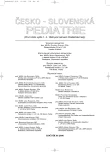Alobar Holoprosencephaly – A Case Report of Two Cases
Authors:
V. Bartoš 1; P. Slávik 2; J. Kršiaková 3; M. Fedor 4; R. Szépeová 5; P. Žúbor 6
Authors‘ workplace:
Ústav patologickej anatómie Jesseniovej lekárskej fakulty a Martinskej fakultnej nemocnice, Martin
vedúci prof. MUDr. L. Plank, CSc., prodekan
1,2; Oddelenie genetiky Martinskej fakultnej nemocnice, Martin
vedúca doc. MUDr. N. Mišovicová, CSc.
3; Klinika detí a dorastu Jesseniovej lekárskej fakulty a Martinskej fakultnej nemocnice, Martin
vedúci prof. MUDr. P. Bánovčin, CSc.
4,5; Gynekologicko-pôrodnícka klinika Jesseniovej lekárskej fakulty a Martinskej fakultnej nemocnice, Martin
vedúci prof. MUDr. J. Danko, CSc.
6
Published in:
Čes-slov Pediat 2006; 61 (7-8): 428-433.
Category:
Case Report
Overview
Holoprosencephaly is a congenital defect of the central nervous system characterized by an incomplete or absent division of the embryonic forebrain – prosencephalon into distinct lateral cerebral hemispheres. This malformation arises during early embryogenesis and is frequently associated with specific craniofacial abnormalities. Based on the cardinal morphologic features the malformation is categorized into 3 main types – alobar, semilobar, lobar form and a special subtype MIV (middle interhemispheric fusion variant).
The authors of the article present a case report of 2 children with alobar type of holoprosencephaly. They demonstrate a clinical course, examinations, complications and autopsy findings. Finally, they describe a classification, etiopathogenesis, morphology and clinical details of this malformation.
Key words:
alobar, semilobar, lobar holoprosencephaly, congenital CNS malformations
Labels
Neonatology Paediatrics General practitioner for children and adolescentsArticle was published in
Czech-Slovak Pediatrics

2006 Issue 7-8
Most read in this issue
- Alobar Holoprosencephaly – A Case Report of Two Cases
- Indication and Principles of Molecular-Genetic Investigation
- The Therapy of the Deep Cartilage Defects in the Knee Joint by the Transplantation of Cultivated Autologous Chondrocytes in Children and Adolescents
- Cardiopulmonary Resuscitation – Novel Recommended Procedures
